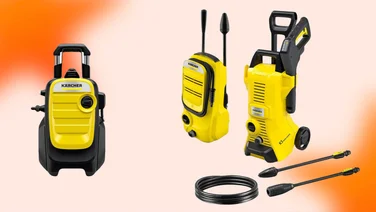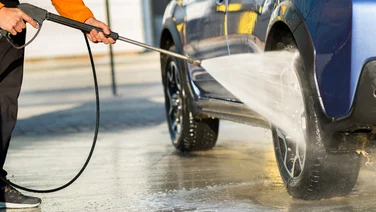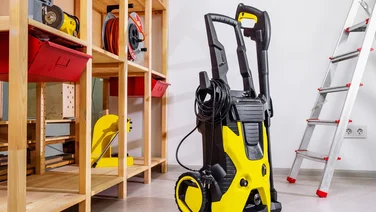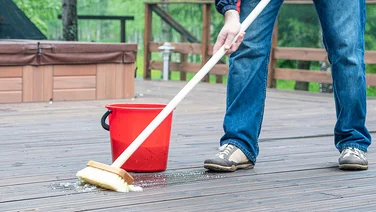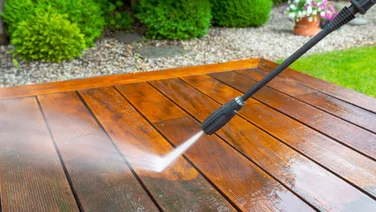To help us provide you with free impartial advice, we may earn a commission if you buy through links on our site. Learn more

Pressure washers are undeniably powerful tools, capable of transforming grimy surfaces into sparkling clean ones in a fraction of the time compared to traditional methods. From cleaning your car to reviving your patio and blasting away stubborn driveway stains, their versatility makes them an important part of every homeowner’s toolkit.
However, it’s also safe to say pressure washers aren’t suitable for use on every surface. Applying high-pressure water to delicate or inappropriate materials can lead to costly damage, meaning some outdoor cleaning jobs are better handled with a bucket and sponge. To get the full lowdown on the dos and don’ts of pressure washing, we spoke to Brian Johnson, Appliance Expert at MyJobQuote.co.uk for more information.
6 things you shouldn’t clean with your pressure washer
1. Windows
While it might be tempting to give those dirty windows a short blast of the pressure washer, you could quickly end up with bigger problems than smudged windows. Appliance Expert Brian says that using a pressure washing on windows can actually be quite dangerous: “Direct spraying, rather than at a 45-degree angle, can break or crack the glass,” he says. “And regardless of that, single glazing may crack under the pressure.”
He also notes that frequent use can also cause long-term wear and tear: “Too high pressure, above 2,000 psi, can damage seals on double glazing and allow moisture to get between the panes,” he says. “The sealant around the window frames could also be damaged, letting water in.”
If you don’t fancy washing the windows the traditional way with a bucket of water, sponge and a squeegee, Brian recommends using a hose instead. “The water pressure will be much lower than a pressure washer,” he says.
Alternatively, why not try a window vacuum? This handheld device combines a squeegee with a suction mechanism, efficiently removing dirty water and cleaning solution to leave windows streak-free and dry with minimal effort.
For higher up windows, if you don’t fancy getting on a ladder, you could use a telescopic window cleaning tool. These typically feature adjustable poles that extend to reach upper windows, often equipped with a brush or squeegee attachment. Some models even have a built-in water feed for more efficient cleaning, making the job quicker and safer.
And if that fails, take Brian’s advice and get the professionals in. “Hire a window cleaner who will have all the right equipment, including ladders for safely reaching upper windows,” he says.
2. Delicate or loose stone, brick and gravel
While some types of strong stone and brick can be pressure washed, older or more delicate types can be damaged. The high pressure can erode the surface, remove mortar and cause cracks. Additionally, any unsecured materials are vulnerable to damage. As Brian notes, “Loose materials such as gravel are not suitable for a pressure washer.”
Instead of pressure washing, stone and brick benefit from gentle hand washing with a soft brush and pH-neutral solution and if needed, specialised stone cleaners are available for tougher stains. A low-pressure garden hose rinse is sufficient for loose dirt, while steam cleaners or gentle patio cleaners provide effective heat-based alternatives.
For gravel surfaces, sweeping or raking will remove leaves and light debris. A garden hose with a very gentle spray can tackle caked-on mud, but use it sparingly to avoid displacing the gravel.
3. Decking
While decking isn’t a total no-no, you do need to approach using a pressure washer with caution. “When cleaning decking with a pressure washer, make sure the pressure is not so high that it strips off the paint or stain,” says Brian. “Use a lower pressure, keep the nozzle at least 6 inches from the surface and use an attachment that fans out the water rather than having a concentrated jet of water. A wide attachment is best for this.”
If in doubt, when it comes to decking, a simple sweep followed by a scrub with a soft brush and mild cleaning solution is often sufficient. For wooden decks, opt for a wood-specific cleaner to remove dirt and algae without damaging the surface. Composite decks, on the other hand, can be cleaned with a gentle soap and water solution, avoiding anything abrasive that could scratch the decking.
Stubborn stains may require specialised deck cleaners or brighteners, to be applied following product instructions. For a thorough rinse, once again, your trusty garden hose, used on a low pressure setting, is the simplest answer.
4. Painted surfaces
Like decking, painted surfaces, particularly those that are old or damaged, are susceptible to damage from pressure washing, so proceed with care. High-pressure water can easily strip away paint, especially if it’s peeling, flaking or already damaged. This can leave unsightly bare patches that will necessitate costly repainting.
Instead, opt for gentle hand washing with a soft sponge or cloth and a mild detergent. For stubborn stains, a low-pressure garden hose with a spray nozzle can be used.
5. Cars
It’s all about how close you get when it comes to using a pressure washer on your car. Too close and you can risk stripping paint from your car, which could eventually lead to rusting and expensive bodywork repairs. Additionally, high pressure can damage delicate trim, seals and even your electronics if water is forced into sensitive areas.
Brian says if you’re careful though, a pressure washer can be an efficient way to clean your car. “Use a 40-degree nozzle and pre-rinse the car to remove loose debris and dirt, including the wheels,” he suggests. “And select a suitable pressure so you don’t dent the bodywork or break the glass – 1,200 psi should be fine.”
Brian suggests changing to a 25-degree nozzle for the tyres so ensure they don’t get damaged. Carefully done, this will prove a much quicker job than using a sponge and bucket, saving you time and effort. If you’re worried about damaging your car though, stick to a garden hose with a spray nozzle, a wash mitt and a bucket of car shampoo.
6. Gutters
Using a pressure washer on guttering is generally not recommended. The force of the water can easily damage the relatively thin materials used in gutters, while components like end caps and downspout connections can be dislodged, causing leaks and drainage issues. It can also force water behind the fascia and soffit boards, resulting in water damage, rot and even mould growth. The high pressure may also launch debris stuck in the gutter, which could damage windows or even cause injury.
Cleaning gutters is a hands-on job, unfortunately. The best way to avoid damage is to climb up and manually remove debris, then rinse with a gentle hose (use a gentle spray attachment if possible). Afterwards, add in some gutter guards – they will keep leaves and debris out, so you won’t have to clean as often.

